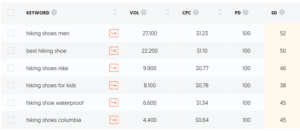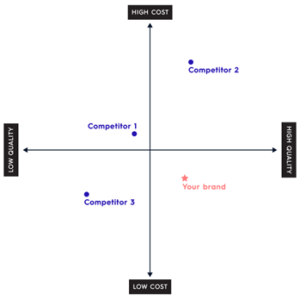In the previous chapter we have defined our target audience. Now, let’s take a dive into the potential of the market in which we operate. How many people matching the requirements of our target audience exist? How many competitors are in the market? What do these competitor’s look like? How or why is our product/service better than that of the competition? This is the information we need for successfully defining the target market.
Keyword analysis
The way I like to start my market analysis is with a basic keyword analysis. Let’s say we are doing a keyword analysis for our hiking shoe company. I like to go to a site such as ubersuggest.com and start very simple, by entering the term “hiking shoes”.
The first data I find is that the search term “hiking shoes” has a monthly search volume of 74.000 in the United States. Which means that 74.000 people enter the words “hiking shoes” in search engines on average monthly.
The next step I like to take is to go to the Keyword Ideas and then Keyword Suggestions tab in Ubersuggest, filtered on search volume. What we see here are keywords related to our originally entered keyword “hiking shoes”. I see the following search terms pop-up:

From the image above we’ve now learned what people find most important when searching for hiking shoes. They most often start with filtering for the right sex, they care about the brand of the shoe, and they are looking for certain functionality that the shoe must have (waterproof).
Next I like to go to the “Related Keywords” tab. For example if there is another well-searched version of the original keyword you entered, you would find it here. A related keyword for our hiking shoe could be – walking shoes, climbing shoes, adventure shoes, waterproof shoes, etc.
While these search terms don’t fully correlate with our original keyword (a climbing shoe is actually something different than a hiking shoe), people could search with these terms while actually meaning to search for a hiking shoe. Therefore it is always good to go to Google yourself, enter these other keywords, and see whether the search results that pop-up are related to your product: the hiking shoe. If the results are related, it could be interesting if you also put effort in finding more information about the target market of these keywords.
So far we’ve only searched a couple of keywords via Ubersuggest. Yet we see that there are tens of thousands people searching monthly in the US. While this number does not correlate with the total target audience (because there also people indirectly in need of a hiking shoe, although they aren’t actively searching for it yet), it is a good start for the information we need for defining the target market.
Competitor analysis
Besides the information we have previously discovered regarding the size (monthly search volume) of the target market, another important piece of information is to define the competitive landscape. How many direct competitors do you have in the geographical area you want to target?
For our hiking shoe company targeting the entire US, that requires a lot of company names to list. Hence, we are only going to name the four biggest competitors who all focus on a different part of the customer experience. How do we find out what that is? The same we started doing it for our own company, we ask the general management of these companies why they built their company in the first place. Or, well, at least something that comes close to it, we checkout all our competitors’ About Us pages and read their mission and vision statements if they have any.
The way I like to do so is through the creation of a competitive matrix. You can choose whichever aspects you like to compare on the axes, as long as the two across from each other are opposites.

Look through the list of competitors and put one (or more) competitors with focus towards one of the points on the axes and place their name next to that axes. This way we are efficiently mapping the competitive landscape and we can take a look at the competitors that are placed next to the same axes as we are. Try answer the following question: “Why would people choose for our product/service in comparison to one of the competitors in the same field?”.
Potential answers could be related to:
Price
Quality
Sustainability
Vision
Service
Defining the target market
To successfully define the target market we need to do two important steps. First of all we need to perform a basic keyword research, to see how many people are actively searching for the product/service we are going to sell. Second, we need to map out our competitors and understand why performing a purchase from our company benefits the potential customer more when compared to one of the competitors.
